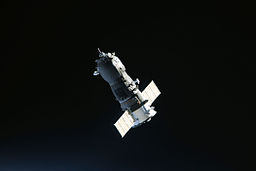
Back مركبة فضائية غير مأهولة Arabic Bespilotna svemirska letjelica BS Nau espacial no tripulada Catalan کەشتیی ئاسمانیی بێسەرنشین CKB فضاپیمای بدون سرنشین Persian חללית לא-מאוישת HE Wahana antariksa nirawak ID Veicolo spaziale senza equipaggio Italian 무인 우주선 Korean Хүнгүй сансрын хөлөг Mongolian
This article needs additional citations for verification. (January 2023) |
Bottom: Spaceplane Buran was launched, orbited Earth, and landed as an uncrewed spacecraft in 1988 (left). Model of James Webb Space Telescope (right).
| Part of a series on |
| Spaceflight |
|---|
 |
|
|
Uncrewed spacecraft or robotic spacecraft are spacecraft without people on board. Uncrewed spacecraft may have varying levels of autonomy from human input, such as remote control, or remote guidance. They may also be autonomous, in which they have a pre-programmed list of operations that will be executed unless otherwise instructed. A robotic spacecraft for scientific measurements is often called a space probe or space observatory.
Many space missions are more suited to telerobotic rather than crewed operation, due to lower cost and risk factors. In addition, some planetary destinations such as Venus or the vicinity of Jupiter are too hostile for human survival, given current technology. Outer planets such as Saturn, Uranus, and Neptune are too distant to reach with current crewed spaceflight technology, so telerobotic probes are the only way to explore them. Telerobotics also allows exploration of regions that are vulnerable to contamination by Earth micro-organisms since spacecraft can be sterilized. Humans can not be sterilized in the same way as a spaceship, as they coexist with numerous micro-organisms, and these micro-organisms are also hard to contain within a spaceship or spacesuit.
The first uncrewed space mission was Sputnik, launched October 4, 1957 to orbit the Earth. Nearly all satellites, landers and rovers are robotic spacecraft. Not every uncrewed spacecraft is a robotic spacecraft; for example, a reflector ball is a non-robotic uncrewed spacecraft. Space missions where other animals but no humans are on-board are called uncrewed missions.
Many habitable spacecraft also have varying levels of robotic features. For example, the space stations Salyut 7 and Mir, and the International Space Station module Zarya, were capable of remote guided station-keeping and docking maneuvers with both resupply craft and new modules. Uncrewed resupply spacecraft are increasingly used for crewed space stations.



